
Ford Kuga engines, driving and performance
Gallery
How does the Ford Kuga drive?
The absence of an ST-badged range-topper shows that the Kuga isn’t designed to be a performance car like a Cupra Ateca or the smaller Ford Puma ST. But, for a family SUV, it’s pretty good at going around corners. The steering feels alive and quick, making you part of the driving experience rather than isolating you from it.
The Kuga sits a bit higher off the ground than a Focus or Puma, so it rolls very slightly more through the corners. You’re not going to be feeling like you’re pressed up against the door handles, but the difference is slightly noticeable and the Kuga is marginally less agile than the Focus. Still, compared to its nearest rivals, the Kuga is much more able to keep keen drivers happy.
Is the Ford Kuga comfortable?
The Kuga’s sporty setup means that the ride is a little on the firm side, with broken road surfaces being slightly more noticeable than in a Hyundai Tucson or Volkswagen Tiguan. But we’d say it’s communicative rather than uncomfortable, because most bumps are stopped from being felt in the cabin.
If you can avoid the allure of the high-spec cars with large wheels, lower-spec cars with smaller wheels offer a more comfortable ride.
What’s the best Ford Kuga engine to get?
Short of a fully electric model, the Ford Kuga has you covered. There’s a petrol, several diesels, a hybrid and a plug-in hybrid, so there’s something whether you’re a motorway muncher or a city slicker.
If you're after a diesel Kuga, you'll need a pre-2024 car – Ford killed off the car's diesel choices at this point. One of the pre-facelift car's three diesel engines should suit you if you do a high annual mileage, or if you need to tow. There’s a 1.5-litre diesel with 120hp that’s not quick but capable of 60mpg, a 150hp mild-hybrid 2.0-litre engine that can manage up to 58mpg, and a four-wheel-drive 2.0-litre diesel with 190hp. It can achieve up to 50mpg and boasts the best towing capacity in the range at 2,100kg.

For lower-mileage drivers, the standard 1.5-litre EcoBoost petrol should fit the bill. It’s reasonably economical, managing up to 43mpg, and is reasonably quick with a sub-10-second 0-62mph time. Importantly, it feels pretty nippy, too, and you can enjoy telling people that it’s the same engine that’s fitted in the fizzy Fiesta ST – albeit with a lower power output. It’s our favourite engine in the Kuga lineup.
Three hybrid models are available in the 2024-onwards Kuga. There are two full ('self-charging') hybrids with either front or four-wheel-drive, and a plug-in-hybrid option that can do up to 40 miles on a charge.
All three hybrids have a 2.5-litre petrol engine and an automatic gearbox, but the plug-in hybrid has a 14.4kWh battery – compared to 1.1kWh for the hybrid. A Kuga PHEV can be fully recharged at a 7kW home wallbox in around three hours, or around double that if charging from a standard three-pin socket.
The eCVT hybrid gearbox is actually pretty decent. It does let the engine rev hard when you really floor it but, most of the time, it just works in the background with the hybrid system. We tested the 183hp four-wheel-drive hybrid, and were impressed by how smooth and hushed the transition from electric to petrol power was. We averaged 48mpg over 300 miles of mixed driving, and the dashboard showed us that about 80 miles of those 300 were done on pure electric power. The all-wheel-drive hybrid and the plug-in hybrid Kugas can match the old diesel model's 2,100kg towing capacity.
Ford Kuga performance
At one end of the range is the 120hp diesel engine, which gets from 0-62mph in around 12 seconds. The diesel’s low-down power does make the car feel quicker than that suggests, but you’ll still need to be a little patient or need lots of revs if you want to get up to speed quickly.
The four-wheel-drive 190hp diesel is the quickest-accelerating version, with the acceleration benchmark completed in 8.7 seconds. All other Kugas take between nine and 10 seconds to reach 62mph, so performance is respectable rather than rapid.


























































